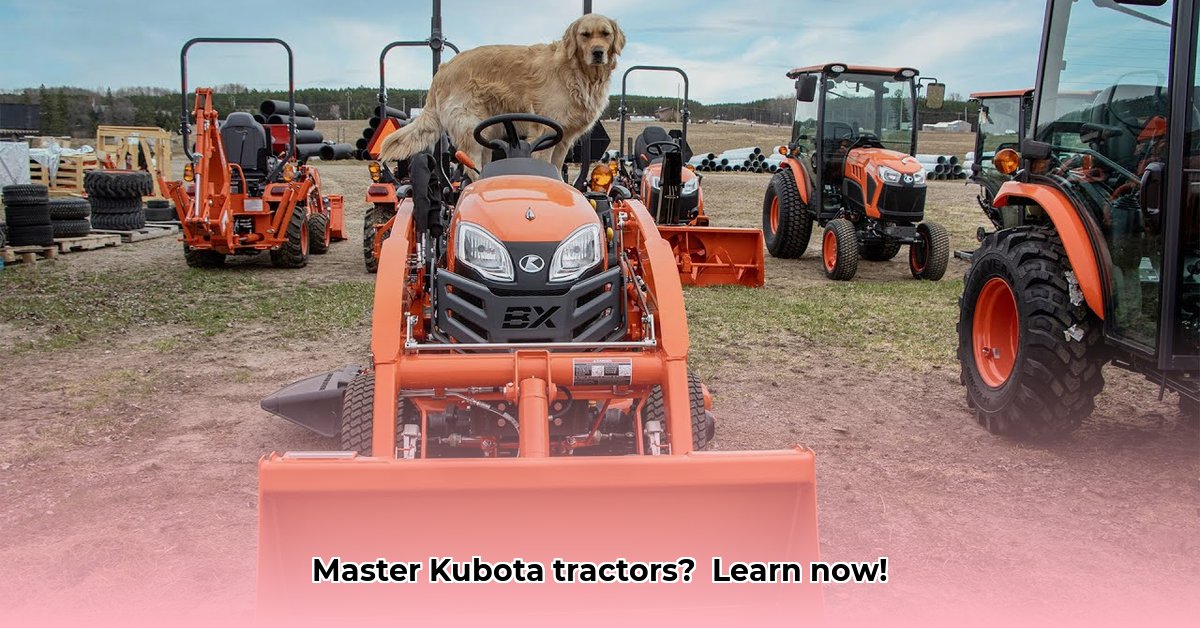
Getting comfortable operating a Kubota tractor involves understanding its controls and prioritizing safety. This guide provides a step-by-step approach, covering pre-operation checks, starting and stopping, operating controls, working with attachments, maintenance, troubleshooting, and safety procedures. For more detailed engine information, see the Kubota Engine Specs.
Pre-Operation Checks: Ensuring a Safe Start
Before starting your Kubota tractor, perform these essential checks:
- Fluid Levels: Check engine oil, coolant, and hydraulic fluid levels using the dipsticks. Low levels can cause serious damage. Top off as needed with the correct fluids specified in your owner's manual.
- Tire Pressure and Condition: Verify tire pressure using the information on the tire sidewall. Proper inflation is crucial for traction and prevents uneven wear. Inspect tires for wear and damage; worn treads reduce stability.
- Safety Systems: Ensure your seatbelt is securely fastened. Test lights, horn, brakes, and all safety switches; malfunctioning safety features can be dangerous.
Starting and Stopping Your Kubota
Starting and stopping correctly prevents accidents and damage. Consult your owner's manual for model-specific details. Here's a general procedure:
- Engage Parking Brake: Firmly engage the parking brake before starting the engine.
- Ignition On: Turn the ignition key to the "on" position. Instrument panel lights should illuminate.
- Clutch Depressed: Fully depress the clutch pedal.
- Start Engine: Turn the key to the "start" position. If the engine doesn't start, check fuel level and battery. Persistent problems require professional attention.
- Gentle Release: Slowly release the clutch pedal, avoiding sudden movements.
- Stopping: Gently depress the clutch pedal, apply the brakes, and firmly engage the parking brake once fully stopped.
Understanding Your Tractor's Controls
Each control plays a crucial role in safe and efficient operation. Refer to your owner's manual for specifics on your model; controls may differ slightly.
| Control | Function | Safety Precautions | Common Mistakes |
|---|---|---|---|
| Clutch | Engages/disengages power to the transmission. | Smooth, controlled movements prevent jerking/stalling. | Jerking the clutch, causing stalling or jerky movements. |
| Brakes (Service & Park) | Service brakes stop; parking brakes hold it stationary. | Ensure brakes function correctly; always use the parking brake when parked. | Forgetting to set the parking brake. |
| Transmission | Selects gear ratios. | Start in low gear, shifting up as needed. Avoid sudden shifts under load. | Incorrect gear selection causing engine stalling. |
| Throttle | Controls engine speed and power. | Avoid sudden changes, especially when using attachments. | Using excessive throttle, leading to inefficiency. |
| PTO (Power Take-Off) | Engages/disengages power shaft for implements. | Only engage with implement securely attached; disengage when finished. | Engaging the PTO with the implement improperly connected. |
| Three-Point Hitch | Lifts/lowers implements. | Secure implement before lifting; lower slowly and cautiously. | Lifting too quickly or without securing the implement. |
| Hydrostatic Lever (if equipped) | Controls speed and direction (some models). | Move smoothly to avoid jerky movements or sudden stops. | Jerky lever movements, causing uncontrolled motion. |
Working with Attachments: Safe Implementation
Using attachments requires careful handling and adherence to safety guidelines.
- Safe Connection: Ensure the attachment is firmly connected to the three-point hitch or PTO using provided pins and locking mechanisms.
- Cautious Operation: Move the attachment slowly and cautiously, especially during the initial engagement. Avoid sudden movements.
- Safe Disconnection: Disengage the PTO, lower the implement, and then disconnect before stopping the engine.
Kubota Tractor Maintenance: Preventative Care
Regular maintenance is vital for optimal performance. Your owner's manual will provide a detailed schedule.
- Oil Changes: Change engine oil at recommended intervals using the specified type and grade.
- Filter Replacements: Regularly replace air, fuel, and hydraulic filters.
- Lubrication: Lubricate moving parts to reduce friction and extend component lifespan.
Troubleshooting Common Issues
If problems arise, consult your owner's manual or a qualified mechanic. Common issues include:
- Engine Won't Start: Check battery, fuel level, and ignition switch.
- Hydraulic Issues: Check fluid levels and look for leaks.
- Transmission Problems: Ensure proper gear engagement and clutch function.
Safety: Always Your Top Priority
Farming involves inherent risks; operating machinery demands extra caution.
- Personal Protective Equipment (PPE): Always wear safety glasses, hearing protection, sturdy boots, and gloves.
- Situational Awareness: Remain alert and aware of your surroundings.
- Emergency Procedures: Familiarize yourself with your tractor's emergency shutdown.
Glossary of Terms
- PTO: Power Take-Off (the system that transmits power from the engine to implements).
- Three-Point Hitch: A system connecting implements to the tractor (rear).
- Hydrostatic Transmission: A transmission system using hydraulic fluid to control speed and direction.
This guide provides basic instructions. Always refer to your Kubota tractor's owner's manual for detailed, model-specific information and safety recommendations. Safe and efficient operation requires practice and a thorough understanding of your equipment. Remember, your safety is paramount.